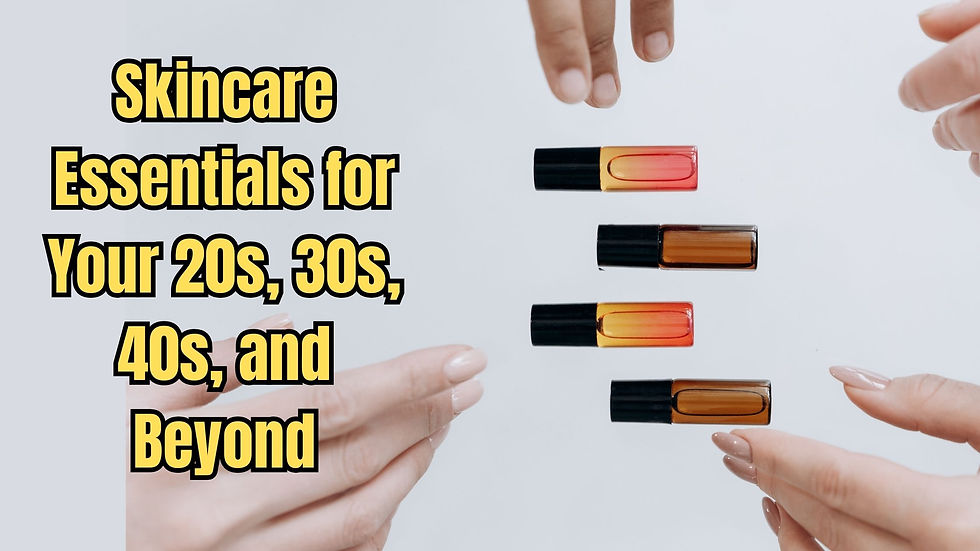The Benefits of Using Clay Masks: Which One Is Right for You?
- Akram Beauty Booth
- Dec 17, 2024
- 4 min read
Updated: Jan 1

Clay masks have been a staple in skincare routines for centuries, and it’s no surprise why. These powerful, natural masks are known for their ability to detoxify, exfoliate, and rejuvenate the skin. With so many types of clay available, each with unique benefits, it’s important to choose the right one for your skin type and concerns.
In this blog post, we’ll explore the benefits of clay masks and help you determine which type of clay mask is best suited for your skin.
Why Use Clay Masks?
Clay masks are packed with minerals that provide a variety of benefits for the skin. Here’s what makes them so effective:
1. Detoxification
Clay masks are excellent at drawing out impurities, toxins, and excess oils from deep within the pores. This makes them ideal for people with acne-prone or oily skin.
2. Oil Control
By absorbing excess sebum, clay masks help to balance oily skin, leaving it feeling fresh and matte without stripping away essential moisture.
3. Gentle Exfoliation
Clays naturally exfoliate the skin by removing dead skin cells, improving texture, and promoting a radiant complexion.
4. Soothing and Calming
Some clays, such as kaolin and pink clay, have soothing properties that help reduce redness and irritation, making them suitable for sensitive skin.
5. Improves Skin Tone and Texture
Regular use of clay masks can help minimize the appearance of pores, even out skin tone, and leave the skin looking smooth and rejuvenated.
Types of Clay Masks and Their Benefits
Each type of clay has unique properties, making it important to choose one that matches your skin’s needs. Here’s a guide to some of the most popular clays:
1. Bentonite Clay: The Deep Detoxifier
Best for: Oily, acne-prone skin
Benefits: Bentonite clay is a powerhouse when it comes to absorbing oil and detoxifying the skin. It’s highly effective at unclogging pores and reducing the appearance of acne.
Tip: Mix with apple cider vinegar for a deep-cleansing mask that tightens pores and leaves your skin feeling squeaky clean.
2. Kaolin Clay: The Gentle Healer
Best for: Sensitive or dry skin
Benefits: Kaolin clay is one of the mildest clays, making it suitable for sensitive skin. It gently exfoliates, removes impurities, and soothes irritation without over-drying the skin.
Varieties: Available in different colors like white (the most gentle), yellow, pink, and red, each offering slightly different benefits.
3. French Green Clay: The Balancer
Best for: Combination to oily skin
Benefits: French green clay is known for its excellent oil-absorbing properties and its ability to draw out impurities. It also contains minerals that can brighten the skin and improve overall tone.
Tip: Use this clay to target areas prone to oiliness, such as the T-zone.
4. Moroccan Red Clay (Rhassoul): The Hydrating Purifier
Best for: Dry or sensitive skin
Benefits: While Rhassoul clay detoxifies like other clays, it is also rich in minerals and provides hydration, making it suitable for dry or mature skin.
Tip: Mix with rose water for a soothing, hydrating mask.
5. Fuller’s Earth Clay: The Skin Brightener
Best for: Dull or pigmented skin
Benefits: Fuller’s Earth clay is excellent at brightening the complexion and reducing pigmentation. It also helps tighten the skin, making it a favorite for anti-aging routines.
Tip: Combine with milk or yogurt for a brightening and moisturizing mask.
How to Use a Clay Mask
To get the most out of your clay mask, follow these simple steps:
Cleanse Your Skin: Start with a clean face to allow the mask to penetrate deeply.
Apply Evenly: Using a brush or your fingers, apply a thin, even layer of the mask to your face, avoiding the eyes and lips.
Don’t Over-Dry: Let the mask sit until it’s almost dry but not completely cracked. Over-drying can strip your skin of natural oils and cause irritation.
Rinse Gently: Use lukewarm water and a soft washcloth to remove the mask. Follow with your regular moisturizer to lock in hydration.
Frequency: Use a clay mask 1–2 times per week, depending on your skin type and concerns.
Tips for Choosing the Right Clay Mask
Know Your Skin Type: Choose a clay mask based on your skin’s needs—whether it’s oil control, hydration, or soothing irritation.
Check Ingredients: Avoid masks with added fragrances or harsh chemicals that could irritate your skin.
Patch Test: If you’re trying a new clay mask, do a patch test on your inner arm to ensure you don’t have an adverse reaction.
DIY Clay Mask Recipes
If you prefer natural skincare, you can create your own clay mask at home:
For Acne-Prone Skin: Mix bentonite clay with apple cider vinegar and a drop of tea tree oil.
For Dry Skin: Combine Rhassoul clay with honey and aloe vera gel.
For Brightening: Mix Fuller’s Earth clay with yogurt and a pinch of turmeric.
Conclusion
Clay masks are a versatile and powerful addition to any skincare routine. With their ability to detoxify, exfoliate, and balance the skin, they cater to a wide range of skin types and concerns. By choosing the right type of clay mask for your skin and using it regularly, you can achieve a clearer, healthier, and more radiant complexion.
Whether you’re dealing with oily skin, dullness, or sensitivity, there’s a clay mask out there for you. Give one a try and enjoy the benefits of this timeless skincare ritual!





Comentarios